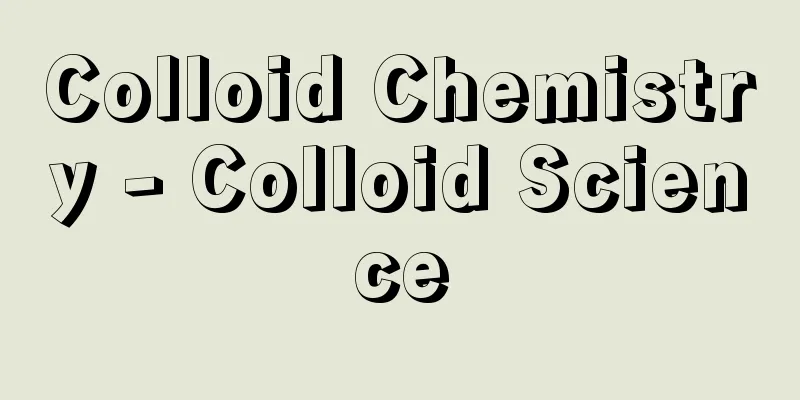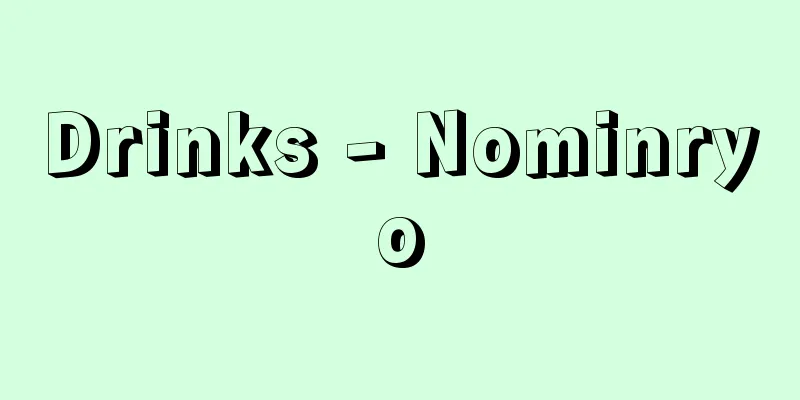Colloid Chemistry - Colloid Science

|
Also called colloid chemistry. A branch of physical chemistry that deals with the physical and chemical properties of materials in a colloidal dispersion. Regardless of the type of substance, it deals with substances that are larger than low molecular weight ( 10-8 cm) and difficult to see under a microscope, so the related fields are extremely broad. It includes inorganic and organic inanimate objects, polymers (synthetic and biological), and microorganisms (bacteria and viruses), so it is often called colloid science or colloidology rather than colloid chemistry these days. As a theoretical system, it is a research field that closely combines the theory of dispersed states and interface chemistry in a complementary manner. This is because the specific surface area (surface area/volume) of colloids is extremely large, and the properties of colloids cannot often be considered without considering the properties of their surface (or interface). Since the molecules of polymers themselves fall within the size range of colloids, they are nothing but molecular colloids in a dispersed state. The substances that T. Graham (1861) originally used to demonstrate the existence of colloids were, in modern times, nothing more than solutions of natural polymers such as glue, protein, starch, and gum arabic. Proteins, the basic substances that make up living organisms, are polymers and fall within the size range of colloids, indicating a connection between life phenomena and colloidal dispersion states. Additionally, the catalytic action of fine particles such as platinum and reduced nickel is a field related to the surface as a site of chemical reactions and the degree of dispersion. The Kolloid Zeitschrift is a journal specializing in colloids that was founded in 1906 by CWW Ostwald, but today the title has been expanded to include und Zeitschrift für Polymere , and it is also listed alongside Colloid and polymer science . In the United States, it is called J. of Colloid and Interface Science . Source: Morikita Publishing "Chemical Dictionary (2nd Edition)" Information about the Chemical Dictionary 2nd Edition |
|
こう質化学ともいう.コロイド分散状態にある物質の物理的化学的性質を取り扱う物理化学の一部門.物質の種類を問わず,低分子(10-8 cm)よりは大きく,顕微鏡で認めにくい程度の大きさをもつ物質を扱うので,その関連する分野はきわめて広い.無機・有機の無生物から高分子(合成,生体),微生物(細菌,ウイルス)まで含まれるので,最近はコロイド化学というよりは,コロイド科学あるいはコロイド学などとよばれることが多い.理論体系としては,分散状態論と界面化学とが相補的に密接に複合した研究分野である.これは,コロイドの比表面積(表面積/体積)がきわめて大きいことによるもので,コロイドの性質はその表面(あるいは界面)の性質を無視しては考えることができないことが多いからである.高分子は分子自体がコロイドの大きさの範囲に入るので,分散状態においては分子コロイドにほかならない.元来,T. Graham(グラハム)(1861年)がコロイドの実在を示すのに用いた物質は,にかわ,タンパク質,デンプン,アラビアゴムなど,いまから考えるとすべて天然高分子の溶液にほかならない.生物体を構成する基本物質であるタンパク質が高分子であり,コロイドの大きさの範囲に入ることは生命現象とコロイド分散状態との関連性を示している.また,白金や還元ニッケルなどの微粒子の示す触媒作用は,化学反応の場としての表面と分散度とに関連する分野である.Kolloid Zeitschriftは,1906年,C.W.W. Ostwald(オストワルト)によって創刊されたコロイド専門雑誌であるが,現在,これにund Zeitschrift für Polymereが付加され,さらにColloid and polymer scienceと併記されている.アメリカではJ. of Colloid and Interface Scienceが発行されている. 出典 森北出版「化学辞典(第2版)」化学辞典 第2版について 情報 |
>>: Colloid - Colloid (English spelling)
Recommend
Duchesnea indica (English name) Duchesneaindica
…[Naruhashi Naohiro]. . … *Some of the terminolog...
Search of the house - kataku sosaku
It refers to entering a person's residence to...
Thumb - thumb
〘Noun〙① The finger on the hand or foot that is loc...
Society
Society refers to a state in which multiple people...
Niihama Plain - Niihama Heiya
An alluvial plain formed by the Kokuryo River and...
Superior [Lake] - Superior
One of the five Great Lakes in North America. With...
Podostemonaceae
…Although it is not an economically exploitable p...
Helvétius, Claude Adrien
Born: January 26, 1715, Paris Died December 26, 17...
Alpine pastures - Alp pastures
…For pasture farming, the high grasslands called ...
Wells Cathedral - Wells Cathedral
St. Andrew's Cathedral is located in Wells, a ...
Rajarani (English spelling)
...The Liṅgarāja Temple, built around 1000, is sa...
Granth Sahib (English spelling)
…Guru Arjun moved to Amritsar and built the Harma...
Lichen Widal - Lichen Widal
...The main diseases are as follows. (1) Lichen W...
Périgord (English spelling)
The name of the region in the southwest of France,...
Ezo striped white butterfly (English name: green-veined white)
A butterfly belonging to the family Pieridae, ord...









